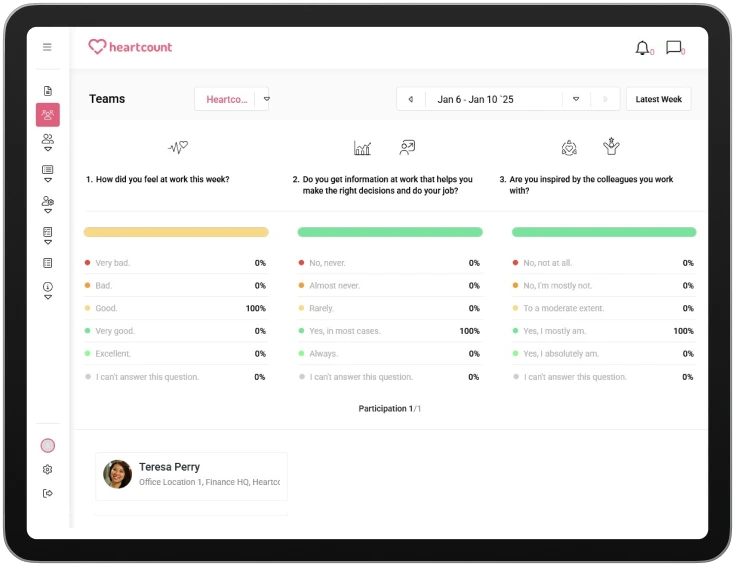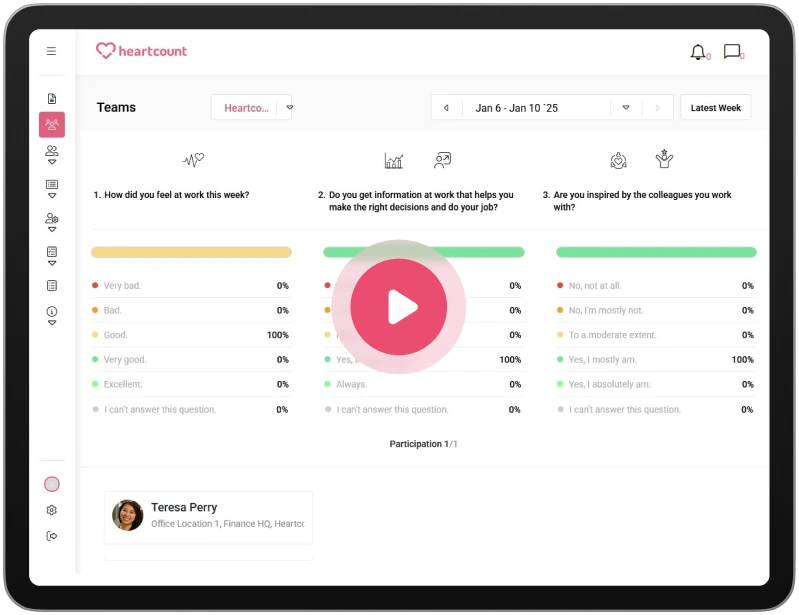What Is a High-Performance Culture – and How Do You Build One That Lasts?

Creating a high-performance culture is no longer a competitive advantage — it’s a necessity. In today’s fast-moving, talent-driven economy, organisations with clear values, engaged teams, and agile leadership are outpacing those still operating under rigid, top-down models. According to McKinsey, companies with strong cultures deliver up to three times higher total returns to shareholders than those with weaker ones — a clear signal that culture isn’t just an HR initiative, but a driver of business success.
But what is a high-performance culture, really? How does it differ from traditional workplace culture? And more importantly, how can you build one that actually lasts?
In this blog, we’ll break down what defines a high-performance culture, explore its key characteristics, and outline a practical step-by-step framework for creating one in your organisation. You’ll also learn how to measure culture performance over time, avoid common missteps, and see real-world examples of performance culture in action — all backed by insights from behavioural research, industry best practices, and tools like HeartCount that make culture measurable and actionable.
If you’re wondering how to build a high-performance culture that engages, retains, and elevates your people, you’re in the right place.
-
1.What Is a High-Performance Culture?
-
2.Why Building a High-Performance Culture Pays Off
-
3.How to Build a High-Performance Culture (Step-by-Step)
-
4.The HeartCount Framework for High-Performance Culture
-
5.How to Measure and Sustain a High-Performance Culture
-
6.Examples of High-Performance Culture in Action
-
7.Common Mistakes to Avoid
-
8.FAQ: High-Performance Culture Explained
Creating a high-performance culture is no longer a competitive advantage — it’s a necessity. In today’s fast-moving, talent-driven economy, organisations with clear values, engaged teams, and agile leadership are outpacing those still operating under rigid, top-down models. According to McKinsey, companies with strong cultures deliver up to three times higher total returns to shareholders than those with weaker ones — a clear signal that culture isn’t just an HR initiative, but a driver of business success.
But what is a high-performance culture, really? How does it differ from traditional workplace culture? And more importantly, how can you build one that actually lasts?
In this blog, we’ll break down what defines a high-performance culture, explore its key characteristics, and outline a practical step-by-step framework for creating one in your organisation. You’ll also learn how to measure culture performance over time, avoid common missteps, and see real-world examples of performance culture in action — all backed by insights from behavioural research, industry best practices, and tools like HeartCount that make culture measurable and actionable.
If you’re wondering how to build a high-performance culture that engages, retains, and elevates your people, you’re in the right place.
What Is a High-Performance Culture?
A high-performance culture is a work environment where individuals and teams consistently go beyond baseline expectations — not because they’re micromanaged, but because they’re deeply connected to the organisation’s purpose, values, and goals. In this type of culture, people are trusted, empowered, and held accountable in equal measure.
Rather than focusing purely on outputs, a high performance culture prioritises behaviours and systems that sustain excellence over time. That includes clarity of purpose, open communication, psychological safety, and real-time feedback mechanisms. Organisations with this mindset don’t just adapt to change — they thrive in it.
By integrating a structured performance culture into everything from recruitment to recognition, businesses can foster an environment where people are intrinsically motivated and teams are aligned, resilient, and continuously learning.
Performance Culture vs. Traditional Culture
The differences between a performance culture and a traditional workplace culture are often stark — not just in outcomes, but in mindset, leadership style, and how people interact day to day. Here’s a side-by-side breakdown:
| Aspect | Traditional Culture | High-Performance Culture |
| Leadership Style | Top-down, directive | Supportive, empowering, coaching-oriented |
| Decision-Making | Centralised, slow | Distributed, agile, often team-led |
| Feedback | Infrequent (usually annual) | Continuous, two-way, built into everyday workflows |
| Accountability | Enforced through control | Driven by autonomy and ownership |
| Purpose & Values | Often aspirational and disconnected from work | Embedded in daily actions and used to guide decisions |
| Innovation | Risk-averse, slow to adopt change | Encourages experimentation, learns from failure |
| Employee Role | Task-focused, siloed | Outcome-focused, collaborative, and empowered |
| Use of Data | Used retroactively for performance reviews | Used proactively to spot engagement trends and act in real time |
Organisations that shift from a traditional to a high performance culture often see improved retention, agility, and employee engagement. Tools like HeartCount’s data-driven insights can help make that transition measurable and sustainable.
Why This Matters in 2025
In 2025, cultivating a high-performance culture is more critical than ever. As organizations navigate rapid technological advancements and evolving workforce expectations, a robust performance culture serves as a strategic differentiator.
Research indicates that companies with strong, well-defined cultures experience significantly higher financial returns. According to a study by McKinsey & Company, organizations with strong cultures achieve up to three times higher total returns to shareholders compared to those with weaker cultures.
Furthermore, the European tech sector exemplifies how a positive work culture can attract and retain top talent. Companies emphasizing work-life balance, employee development, and inclusive environments are more successful in drawing skilled professionals, even in competitive markets.
In this landscape, tools that provide real-time insights into employee engagement, such as HeartCount’s automated pulse-check surveys, become invaluable. They enable organizations to proactively address concerns, foster engagement, and maintain a culture that supports high performance.
Key Characteristics of a High-Performance Culture
To build a high-performance culture that lasts, it’s crucial to understand what is a high performance culture in practice — not just in theory. These cultures are shaped by more than goals or metrics; they’re defined by shared behaviours, consistent leadership, and a work environment that supports autonomy, feedback, and learning. Below are six traits that consistently show up in high-performing organisations.
1. Clear Purpose and Aligned Values
Purpose isn’t just a slogan — it’s a guiding force that informs strategy, hiring, and daily decisions. In a high-performance culture, values are not just written on the wall but actively lived and reinforced. When employees understand the why behind their work and see that leadership models those values, motivation and engagement rise.
HeartCount’s employee engagement model reinforces the importance of alignment between values, culture, and everyday experiences, showing how purpose-driven cultures outperform their peers in both retention and innovation.
2. Inspiring, Accountable Leadership
Leaders in high-performing organisations do more than manage — they inspire, develop, and stay accountable. They’re visible, transparent, and they set a clear tone for what success looks like. Teams perform better when leadership communicates openly and leads by example, especially during periods of uncertainty.
Using data-driven insights from platforms like HeartCount can help leaders identify hidden engagement gaps and respond with targeted support.
3. Trust, Safety, and Open Feedback Loops
Psychological safety is a non-negotiable foundation of a high-performance culture. Employees need to feel comfortable sharing ideas, surfacing concerns, or admitting mistakes without fear of blame. Open, regular feedback creates a loop of trust and continuous improvement.
Companies that implement effective feedback systems build stronger team dynamics and reduce costly miscommunication. It also ensures leaders stay connected to sentiment across all levels of the organisation.
4. Continuous Growth and Learning Mindset
A static workforce is a fragile one. In high-performing cultures, learning isn’t a one-off event — it’s woven into the fabric of daily work. This includes stretch assignments, coaching, mentoring, and access to learning resources.
Employees who are given room to grow are more likely to stay engaged and contribute at a higher level. This ties directly into employee satisfaction and retention.
5. Ownership and High Autonomy Teams
Teams thrive when they are given ownership over outcomes — not just tasks. Autonomy encourages innovation, speeds up execution, and increases accountability. A performance culture trusts people to do great work, then gets out of the way.
To support autonomy, organisations must invest in clear goals, transparent communication, and systems that help measure progress. Tools like HeartCount enable managers to stay aligned with teams without micromanaging.
6. Agility and Data-Driven Decision Making
In a world that changes quickly, organisations must adapt just as fast. High-performance cultures embrace agility, using real-time data to guide decisions rather than relying on instinct or legacy processes.
HeartCount’s pulse-check features allow businesses to track engagement, mood, and alignment week by week — not once a year. This agility leads to faster course-correction, more resilient teams, and a culture of proactive leadership.
Why Building a High-Performance Culture Pays Off
Creating a high performance culture isn’t just about team morale — it delivers tangible business results. Companies that invest in this kind of environment see measurable improvements across retention, innovation, collaboration, and agility. Here’s how.
Increased Retention and Team Engagement
In a strong performance culture, people feel seen, heard, and valued. This emotional connection to the workplace drives long-term commitment. Research shows that engaged employees are 87% less likely to leave their organisation. Regular feedback, recognition, and purpose-driven leadership are key drivers — all elements embedded in high-performance cultures.
Tools like HeartCount’s automated pulse-check surveys make it easier to track engagement in real time, helping managers act before disengagement turns into attrition.
Higher Innovation, Productivity, and Profitability
Empowered, motivated teams don’t just meet expectations — they exceed them. By encouraging autonomy, continuous improvement, and collaboration, high-performance cultures create fertile ground for innovation.
When you combine purpose with psychological safety and a growth mindset, teams are more willing to experiment and iterate. As outlined in HeartCount’s article on the ROI of employee engagement, organisations that prioritise culture can see up to 21% higher profitability and 17% more productivity.
Better Leadership Visibility and Collaboration
When data and feedback flow freely, leaders gain a clearer picture of what’s happening within their teams. This makes it easier to align people around shared goals and identify who needs support.
By integrating a data-driven insights approach, organisations can close the gap between top-level strategy and team-level action — making leadership more responsive and effective.
Real-Time Adaptability in Uncertain Environments
In volatile markets, agility is everything. A high performance culture allows companies to adapt quickly without losing momentum or morale. Continuous listening, like through pulse surveys, helps leaders stay close to shifting needs.
This adaptability doesn’t just support survival — it fosters resilience, allowing teams to thrive even when change is constant.
COLLECT
How to Build a High-Performance Culture (Step-by-Step)
While understanding what a high performance culture is provides the foundation, building one requires a deliberate and consistent approach. It’s not about launching a one-off initiative — it’s about embedding performance values into everyday actions, systems, and leadership behaviours. Here’s how to build a high performance culture in six actionable steps.
1. Define Cultural Values and What “High Performance” Means to You
Every organisation is different. Before you can cultivate a performance culture, you need to clarify what high performance looks like in your context. Define specific values and behaviours that align with your goals and ensure they’re reflected in hiring, onboarding, and performance evaluations.
A clearly articulated culture makes it easier to attract and retain talent — and tools like employee satisfaction surveys can help you gauge whether those values are being lived out across the business.
2. Lead by Example: Equip and Align Your Leaders
Culture starts at the top. Leaders must consistently model the behaviours they expect from others — whether that’s transparent communication, accountability, or adaptability. Equip your managers with the skills, support, and feedback they need to lead with intention.
Creating a high performance culture means ensuring every leader is aligned with core values and actively coaching their teams in line with them.
3. Implement Continuous Feedback and Listening Practices
Feedback shouldn’t be reserved for annual reviews. High-performing cultures build mechanisms for ongoing two-way feedback. This includes structured one-on-ones, peer feedback, and anonymous surveys that encourage open dialogue.
Explore HeartCount’s guide on how to drive employee engagement to see how continuous listening builds trust and accelerates growth.
4. Link Goals to Behaviour: Performance Management That Works
Goals matter, but so do the behaviours that drive them. Align performance metrics with the cultural values you’ve defined. Recognise not just what was achieved, but how it was achieved. This promotes long-term success over short-term wins.
An effective high performance culture framework connects individual goals to team outcomes, creating clarity and accountability without rigidity.
5. Reinforce Wins and Coach Through Gaps
Reinforcement is crucial — especially when behaviours reflect your core culture. Celebrate progress openly, and ensure recognition is meaningful and timely. At the same time, address gaps through coaching, not punishment.
This balance between support and challenge strengthens team trust and supports the growth mindset central to creating a high performance culture.
6. Iterate with Pulse Data — Not Just Annual Surveys
HeartCount helps you measure engagement in real time.
Relying on outdated, once-a-year surveys leaves too many blind spots. Modern performance cultures use pulse check-ins to track engagement, sentiment, and culture health on a weekly or monthly basis.
By gathering regular feedback, acting on it quickly, and closing the loop, organisations become more responsive — and far more effective at sustaining momentum.
The HeartCount Framework for High-Performance Culture
Building a high-performance culture is one thing — maintaining it requires visibility, rhythm, and responsiveness. That’s where the HeartCount framework comes in. It’s designed to help organisations turn employee feedback into continuous cultural improvement by making engagement measurable and actionable.
Pulse Check-In → Analyze Signals → Share Insights → Coach and Act
This four-stage loop is at the core of how HeartCount supports high-performance teams:
- Pulse Check-In: Employees regularly answer short, meaningful questions that assess sentiment, workload, motivation, and alignment. These take less than a minute but provide rich data.
- Analyze Signals: The platform detects trends, patterns, and emerging issues — such as signs of disengagement or burnout — before they impact performance culture.
- Share Insights: Real-time dashboards make it easy for leaders and HR to see what’s working and where interventions may be needed. These insights help drive smarter, more human-centric decisions.
- Coach and Act: With visibility into the right data, managers can proactively coach their teams, celebrate wins, and adjust priorities in line with both performance goals and employee well-being.
This framework is especially useful for teams that want to move beyond static performance reviews and into a dynamic, feedback-driven environment.
How to Measure and Sustain a High-Performance Culture
Even the strongest culture can drift without regular check-ins and course corrections. Sustaining a high performance culture means treating culture as a living system — one that’s constantly influenced by sentiment, leadership behaviours, organisational change, and external pressures.
Here’s how high-performing companies stay aligned and responsive over time.
Track Employee Sentiment Weekly
Culture shifts when people’s experiences shift. That’s why high-performing teams track sentiment weekly or biweekly, not just during an annual survey. Frequent listening reveals small problems before they become systemic and keeps teams feeling heard.
Using short, consistent pulse questions helps measure what truly matters — like commitment, energy, and clarity.
Monitor Leading Indicators (Engagement, Commitment, Risk)
Rather than relying solely on lagging metrics like turnover or performance reviews, successful organisations track leading indicators such as:
- Emotional engagement
- Team cohesion
- Confidence in leadership
- Perceived psychological safety
These metrics provide an early warning system for culture erosion and make it easier to respond in real time.
HeartCount’s platform is designed specifically for this — offering real-time data that gives leaders visibility into the health of their performance culture before results suffer.
Close the Feedback Loop: Show You’re Listening
One of the biggest mistakes companies make is collecting feedback without acting on it. When employees don’t see change, trust erodes.

Sustaining a high performance culture means visibly responding to insights — even small changes — and letting people know their voices shaped the outcome. HeartCount’s blog on employee engagement and retention explores this feedback-action loop in detail.
Leverage HeartCount for Anonymous, Actionable Feedback
Anonymous tools help create psychological safety, especially for distributed or hybrid teams. HeartCount’s surveys provide not just data, but actionable insights — allowing managers to turn feedback into focused conversations, adjustments, and recognition.
When feedback becomes part of the rhythm of work, organisations stay agile, connected, and aligned — the hallmarks of a truly high-performance culture.
UNDERSTAND
Examples of High-Performance Culture in Action
While frameworks and theory are essential, it’s real-world application that proves the value of a high performance culture. From scaling start-ups to hybrid teams and people-first enterprises, the most successful organisations embed culture into every interaction — not just strategy decks.
Here are three examples of how high-performance culture shows up in different contexts:
Culture in Scale-Ups: Autonomy with Accountability
High-growth companies thrive when teams are trusted to move fast — but only when accountability keeps pace. Start-ups with a strong performance culture empower individuals to own outcomes while providing just enough structure to keep alignment.
According to research from Harvard Business Review, scale-ups that establish trust and shared accountability early grow faster and more sustainably than those that focus solely on hierarchy.
This blend of autonomy and clarity accelerates innovation without sacrificing quality or team cohesion.
Culture in Hybrid Teams: Pulse Data to Bridge Distance
In remote and hybrid environments, distance can easily dilute culture. High-performing hybrid teams rely on consistent communication, shared rituals, and pulse data to stay connected.
Using tools like HeartCount, these teams track engagement signals weekly, then act on them quickly — bridging the gap between distributed employees and leadership.
Culture in People-First Companies: Listening Drives Retention
Organisations that lead with empathy build cultures that outperform. By investing in ongoing employee feedback and acting on it transparently, people-first companies reduce turnover and strengthen trust.
Gallup reports that employees who strongly agree their employer listens to their feedback are 4.6 times more likely to feel empowered to perform their best work.
Listening isn’t just good practice — it’s a core driver of loyalty and sustained performance.
Common Mistakes to Avoid
Even well-intentioned efforts to improve workplace culture can fall flat if they’re built on the wrong assumptions. When creating a high performance culture, it’s just as important to know what not to do. Below are some of the most common pitfalls that can undermine performance and engagement.
Confusing Output with Culture
High output doesn’t automatically mean you have a high-performance culture. Teams might be productive in the short term while burning out, feeling undervalued, or lacking alignment. True performance culture is sustainable — it balances outcomes with well-being, trust, and long-term development.
As Deloitte highlights, companies that prioritise both human and business outcomes outperform those that focus solely on results.
Focusing on Perks, Not Principles
Free snacks, flexible hours, or game rooms aren’t a substitute for clear values, good leadership, and mutual respect. While perks might support morale, they don’t build resilience, clarity, or accountability — all essential traits in a high-performance environment.
Companies that rely too heavily on surface-level benefits without strengthening leadership behaviours or performance systems risk disengagement, especially in hybrid or fast-scaling settings.
Building Culture Without Feedback Systems
You can’t manage what you don’t measure. Attempting to build or scale a high performance culture without structured feedback loops is like flying blind. Without insight into employee sentiment, motivation, or alignment, leadership is left guessing.
Tools like HeartCount — which offer real-time, anonymous feedback — close this gap and create a foundation for trust and continuous improvement. As outlined in HeartCount’s post on employee satisfaction surveys, listening isn’t just a step in the process — it’s the mechanism that drives lasting culture change.
ACT
FAQ: High-Performance Culture Explained
What is a high-performance organizational culture?
A high-performance organizational culture is one where values, behaviours, and systems align to consistently support strong results and employee engagement. It focuses on how work gets done, not just what gets achieved, fostering trust, clarity, and ongoing feedback.
How do you build a high-performance culture?
Building a high-performance culture starts with defining what high performance means to your organisation. From there, align leadership, communication, and performance systems around those values. It’s about embedding culture into everyday actions, not just policies.
What are the key traits of a performance culture?
Key traits include purpose-driven work, inspiring leadership, open feedback, personal accountability, and a learning mindset. In a high performance culture, employees feel trusted and motivated because they know their work matters.
How can you measure culture performance over time?
Culture performance is best measured through frequent pulse check-ins that track engagement, alignment, and potential risks. Rather than waiting for annual surveys, high-performing organisations act on real-time feedback to stay ahead of issues.
Can you have high performance without burnout?
Yes — when expectations are clear, leadership is supportive, and employees have autonomy, high performance is sustainable. A strong performance culture actually protects against burnout by creating balance and psychological safety.











